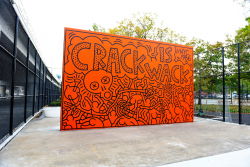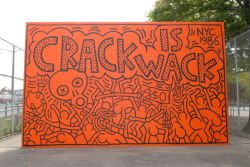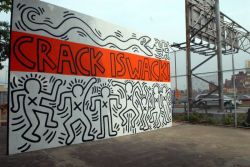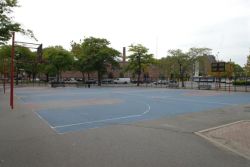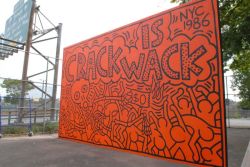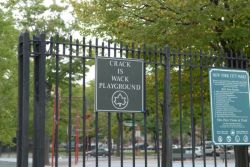Crack Is Wack Playground
View all monuments in NYC Parks, as well as temporary public art installations on our NYC Public Art Map and Guide.
Crack Is Wack
| Dedicated: | 1986 |
| Location: | E 128 ST, 2 AVE & HARLEM RIVER DRIVE |
Artwork History
Famed graffiti artist Keith Haring (1958-1990) painted this fanciful mural, located at East 128th Street and the Harlem River Drive, in 1986. Painted on the northern face of the handball court wall, the mural is composed of Haring’s signature kinetic figures and abstract forms in bold outlines. Crack is a highly potent, addictive, and dangerous form of smokable cocaine whose use reached epidemic proportions in the mid- to late 1980s. Haring’s mural cautions youth against the drug’s use.
Keith Haring was born on May 4, 1958 in Reading, Pennsylvania, and grew up in the neighboring town of Kutztown. His first one-man exhibition was at the Pittsburgh Center for the Arts in 1978, and he moved to New York City that same year to study at the School of Visual Arts. In the early 1980s, the young artist first attained notoriety by using the methods of graffiti to literally make his mark on the City. Creating a style which would soon become renowned worldwide, Haring “tagged” in chalk outlines buoyant interlocking bodies on the black poster mounts of New York City subway stations. His vocabulary of images - such as the radiant child and barking dog - soon became instantly recognizable. Also, by using chalk, a temporary medium, he did not commit large-scale vandalism.
Haring went on to have numerous exhibitions of his work and was represented by such well-known galleries as Tony Shafrazi, Andre Emmerich, and Leo Castelli. He was prolific in his artwork, expansive in support of social causes, and went on to help choreograph music videos and produce coloring books and t-shirts for children. He opened his Pop Shop on Lafayette Street in 1986, selling souvenirs of his creations, the proceeds of which helped finance his charitable causes, such as “Learning Through Art” and “Doing Art Together,” two programs which brought art to schools. He provided funds for numerous children’s organizations, supported efforts to oppose apartheid, and donated designs and funds to advance the cause of AIDS research.
In 1986, two of Haring’s sculptures, one untitled and the other dubbed Blue Curling Dog, were displayed temporarily at Dag Hammarskjold Plaza in Manhattan. The sculptures were also displayed in Riverside Park in 1988. In 1987, Haring painted a large mural at the Carmine Recreation Center’s outdoor pool in Lower Manhattan. The mural still exists today.
Keith Haring died of AIDS on February 16, 1990. Not yet 32 years old, he left a legacy of art that was popular on a universal level and garnered widespread critical acclaim. A foundation in his memory was established, which continues to support the organizations he championed. From 1991 to 1992, Haring’s Balancing the Dogwas displayed in Dante Park, and in 1997 the Public Art Fund, in collaboration with the Estate of Keith Haring, organized a multi-site installation of his outdoor sculptures at Central Park’s Doris Freedman Plaza and along the Park Avenue Malls. This public exhibition occurred simultaneously with a retrospective at the Whitney Museum of American Art.
The Crack is Wack mural is a lasting reminder of Haring’s art, which first arose in public spaces and continues to instruct and inspire through its wit and vibrancy.
Artwork Details
| Description: | Two murals on either side of concrete handball wall |
| Materials: | Paint |
| Fabricator: | Keith Haring (artist) |
| Donor: | Keith Haring |
| Cast: | 1986 |
Please note, the NAME field includes a primary designation as well as alternate namingsoften in common or popular usage. The DEDICATED field refers to the most recent dedication, most often, butnot necessarily the original dedication date. If the monument did not have a formal dedication, the yearlisted reflects the date of installation.
For more information, please contact Art & Antiquities at (212) 360-8163.
Check out your park's Vital Signs
Clean & Safe
Green & Resilient
Empowered & Engaged Users
Share your feedback or learn more about how this park is part of a
Vital Park System






